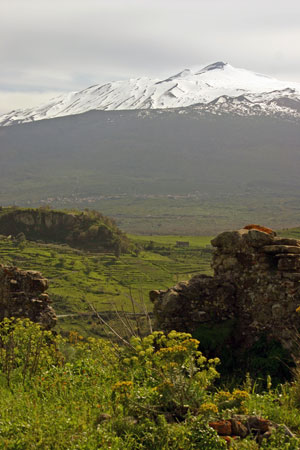Etna excursions: Etna and gastronomy
This trip lasts about 6-7 hours
 Our destination today is the south of Mt Etna.
Our destination today is the south of Mt Etna.
On the road you will see some typical towns like Santa Venerina, Zafferana Etnea. After one hour and an half ride, you will reach the “Silvestri Craters”
located at 1850 meters. Possibility of nice walks on the cold lava rivers from the last three years.
Eventually, you can purchase an optional trip to get almost to the top of the volcano (3000 mts): first you will take the cable-car up to
2600 meters, then you will board all-terrain vehicles that will take you to the foot of the main mouth after we will then visit
a local family farm where we stop for lunch and we will try the Sicilian specialties after lunch we will have
a tasting of wines return to the hotel at about 4.30pm.
Zafferana Etnea
The town spread around the Priory of San Giacomo, founded in 1387 in the upper part of the Valle del Bove, the point of confluence of
the lava streams from Etna's Eastern craters which frequently have destroyed the town, which has always been rebuilt.
Zafferana Etnea was threatened by the 1992 volcanic eruption of Mt. Etna.
It is now a summer resort with views of landscapes toward both the mountain and the sea.
The second Sunday in August is the Festa of Madonna della Provvidenza. There is a festival of grapes, bottled fruit, mushrooms, honey,
wine and chestnuts in October.
Zafferana, along with Nicolosi, is now regarded as one of the major tourist stopping points for summer and winter expeditions to the summit of Mt. Etna.
Etna
The most famous of most recent eruptions took place in 1669 when a cleft opened from the crater right down to Nicolosi
and out poured a river of lava that spread over a kilometre into the Ionian sea, devastating everything in its path and killing 20.000 people.
In the 18th and 19th century have been recorded about 30 other eruptions. In May 1923, a terrible fracture out poured lava almost until the
town of Linguaglossa.
On November 1928, during the most deadly eruption of the century, two cascades of fire shot up from a deep cleft in the mountain and
destroyed the town of Mascali, and also interrupted the railway from Catania to Messina.
In 1983 Etna has been declared a
“Regional Park”,
a protected mountain and it has been divided into three different zones: the lower
slopes are under cultivation, those just above are wooded and the uppermost are desert.
Typical crops are: lemons, oranges, cherries, pistachios, and wine grapes.
A volcanic vegetation is also protected: tree spurge, a local variety of milk-vetch, wild violet, and groundsel.
In the woods you can see broom, chestnut, birch, beech, pine and oak trees.
Wild animals also live and are protected in the area: porcupine, fox, wild cat, weasel, marten, dormouse, woodpecker, kestrel,
buzzard and few reptiles like the asp viper.




